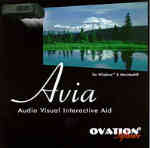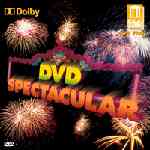Audio / Video Test Tools - November, 1997
By Stacey L. Spears
![]()
 |
AVIA Ovation Software, Inc. 200 Putnam Street. Suite 310, Marietta, Ohio 95750 (800) 572-3917; $69.95
|
Audio Visual Interactive Aid (AVIA) is a computer-based product by Ovation Software to aid you in the setup of your home theater system. Not only does it have the audio and video test patterns, it also contains in-depth information on "tweaking" your theater.
AVIA is different than the other tools being reviewed here. It is the only one that requires a PC or a Mac to use. It also requires a sound card if you want to use the audio test tones, and a video card with a composite/S-Video output or an external PC-to-TV converter to use the video test patterns.
While there are color bar patterns to set color and tint, I have found from experience that you must base these settings on each and every source component you have. For example, you must adjust your front panel controls based on your DVD player to get an accurate picture from that source. You must also then re-adjust the front panel settings for your LD player. The reason for this is that each source’s output is different, so you must compensate for the differences by changing the TV’s controls. The test patterns on this CD-ROM are useful if you plan on using your TV to view your PC, and works great if you are a game player. But actually basing your front panel controls off of this CD will not benefit your other sources.
The CD-ROM includes 3 color filters, one red, green, and blue. The blue filter is used to adjust color and tint, while the red and green are VERY useful for testing the TV’s color decoder. There is a section that allows you to test the color decoder, and it walks you through, and in the end it tells you if the red is being over driven or green, etc.
The product covers everything that you could possible think of. This includes audio and video sources, cables, viewing distances, room lighting, and more. There are videos that show you how to perform some of the tasks, and this can be very helpful. How many times have you read how do so something, but have no reference and must interpret it yourself? This is not necessary with the AVIA software since there is an animated video showing you exactly what they are referring to.
Most of the program is based on a computer generated living room. From here you can click on a part of the room you want to know about, such as the TV, back wall (bias light), couch, speakers, and so on. Something I found very useful is the seating distance screen. On this screen you enter your TV’s diagonal size for either 4:3 or 16:9, and it will tell you 3 seating positions, the near, best, and far spots. There is another screen that will calculate the resonance mode. It is simple in that it expects four walls, but will give a good idea for most situations none-the-less. There are several other screens for speaker locations. The disc is just packed with valuable information.
I found the disc to be useful more as a reference tool than a signal generator. There are lots of test patterns available for different sources, but very little information on what to do with them or why they are advantageous.
The one thing that bothered me about the product is the setup. An experienced PC user could make it through, but for the average Joe consumer, it can be a little complicated. Of course, readers of Secrets are PC users, so this criticism is not necessarily important here. You insert the CD in your drive, type run setup.exe. There is no autorun included on the disc. After the install, you must then go and install QuickTime for windows. After installing QT you must then click on the avia.sta file and associate the file with their omoplay.exe. After all of this you are prompted for name, company and product ID. I realize that setup is, or should only be, done once. While this is true, the first impression the user will get of the product is the installation program. I hope these issues are taken care of in future versions of the product.
Conclusion
The product is very good, and the information on the
disc is worth the price of admission. My only real complaint is the setup program, which
is often the last part of the program to be written by programmers and usually has the
least amount of work put into it
. ![]()
 |
DVD Spectacular Delos International 1645 North Vine Street, Suite 340; Hollywood, California 90028 DV7001; (213) 962-2626; $24.98 |
With any new format, the proper test tools necessary to evaluate it should be the first software you buy. Often, having these tools before buying a DVD player will aid you in the buying decision. This DVD comes with an 11-page manual that covers what is on the disc and how to find it. You can either navigate the menus or go directly to the selections. This disc is VERY similar to the Dolby Test DVD but costs less and comes with instructions. To navigate the disc you will use the arrow pad, enter, and return button. The menu button has been disabled on this disc, so if you need to get back to the starting page, you have to use the title button.
The disc is broken down into 6 sections (5 plus the credits).
When the disc first spins up, you are at the main menu. The background image is the same one on the cover of the jewel case but with a little more depth to it. There are 6 buttons. Starting at the left is 1812 Overture, Audio Tests, Video Tests, Bonus Tracks, Credits, and Dolby Trailers.
The first thing on the disc is the "1812 Overture." The Dallas Symphony Orchestra and the Dallas Symphony Chorus performed it. with Andrew Litton conducting. The running time is 16 minutes and 22 seconds. Of course, it is presented in 5 channel Dolby Digital at 448 kb/sec. The first time I heard music in DD was at the HiFi 95 show in Los Angeles. THX and WILSON A/V out of Southern California presented it. This was during the introduction of DD, and the sound was painful to my ears. This DVD from Delos is much, much better. While it does not have the transparency or warmth of the DTS CDs I have, it is a better representation of what a multi-channel recording should be like. The surround channels are used to convey the ambience with the 3 front channels re-creating the performance. This recording is utilizing more bits than the standard DD (384 kb/sec), and it's really pretty good. I have had several non-audiophile friends listen to it, and they enjoyed it.
The next menu item is the "Audio Tests." In this sub-menu, you are presented with several options: System Gain, Channel Check, 5.1 CH Noise Sequence, Pro Logic Noise Sequence, Frequency Response, Polarity, Pro Logic 5.1 CH Switch, and the return button.
- The "System Gain" is a level reference tone, 400 Hz @ -20 dBFS for 30 seconds.
- The channel check presents a voice coming from each channel identifying what channel it is. For example, the left speaker says, "Left."
- The "5.1 CH Noise Sequence" is to set the output levels on your DD decoder.
- The "Pro Logic Noise Sequence" is to set the output levels on you DPL decoder
- The "Frequency Response" takes you to a sub-menu, and from here you can select which channel you would like to perform the sweep on.
- The "Polarity" is used to check the electrical polarity of the output signals. This can also be used to ensure that the delay setting is set properly on your decoder.
- The "Pro Logic 5.1 CH Switch" is used to test the decoder’s ability to switch back and forth between DD and DPL. This is a good test to see how fast your decoder can lock onto the DD bit-stream. Here you will find that not all decoders are created equal!
The next menu item is the "Video Tests." These can be used to help aid in setting up your monitor and to check how the video may be interfering with the Audio. The menu here is not labeled except for indicating buttons 1 through 8. There is no title for any of the patterns. Of all the patterns here, number 5 is the most useful for the average person. This is the color bar pattern, though you will need a blue filter to properly set the color and tint.
The next section is the "Bonus Tracks." Here you get the 16-bit PCM version of the, "1812 Overture" and another 5 CH DD, "The Piano Barcarolle." You can compare the PCM version to the DD. I listened to the 1812 in both straight stereo and in "Trifield" (Meridian Surround Mode). With the DD version, you have better overall imaging, but Trifield did an excellent job.
Now comes my favorite part, the "Dolby Digital Trailers." This disc has the 4 Dolby Digital trailers that are included on some laserdiscs and in the theater. Trailers have become a big thing over the last couple of years, made famous by the THX people. You get the, "Train", "Helicopter", "Egypt", and "Canyon" trailers. They sound much better at home than at any commercial theater I have been to. "The Train", which is the original, is still my favorite, followed closely by "Canyon". This part alone to me is well worth the $24.95 for the disc.
Conclusion
The Delos DVD Spectacular disc will aid reviewers in evaluating DVD players and DD decoders as well as consumers who are looking for the best DVD player they can get. The disc could use some more video test patterns like the PLUGE with Log Gray scale to set the black.
Stacey Spears
![]() � Copyright 1997 Secrets of
Home Theater & High Fidelity
� Copyright 1997 Secrets of
Home Theater & High Fidelity
Return to Table of Contents for this Issue.

